A new show at Power Station of Art showcases artworks from previous Shanghai biennales, Zhang Kun reports in Shanghai.
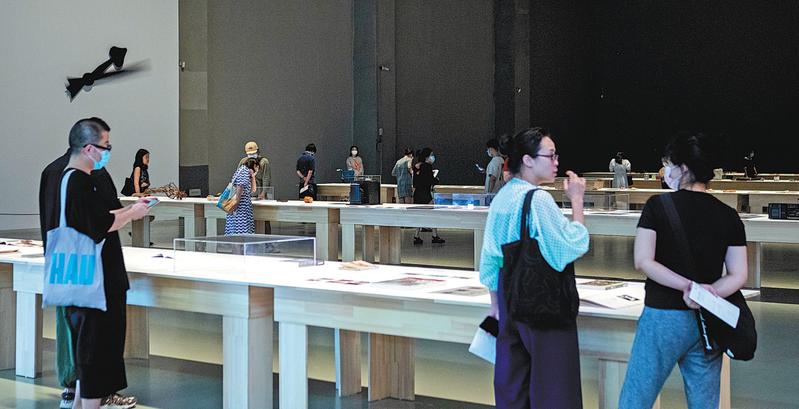 Visitors view works of the ongoing Shanghai Waves: Historical Archives and Works of Shanghai Biennale, which runs through Nov 15. (PHOTO PROVIDED TO CHINA DAILY)
Visitors view works of the ongoing Shanghai Waves: Historical Archives and Works of Shanghai Biennale, which runs through Nov 15. (PHOTO PROVIDED TO CHINA DAILY)
In the main exhibition hall of the Power Station of Art, Shanghai's leading museum for contemporary art, a giant clock on the wall looks like a fan, its two arms turning at 60 times the speed of a regular timer.
The installation, titled Dang, Dang, Dang, was created by Shanghai-based artist Xu Zhen for the 2004 Shanghai Biennale. The original project was a bold readjustment of the vintage clock on the bell tower of the Shanghai Art Museum, where the biannual celebration of contemporary art took place from 1996 to 2012.
The artwork is one of the more than 60 exhibits at the new exhibition, Shanghai Waves: Historical Archives and Works of Shanghai Biennale. Running from July 31 to Nov 15, the exhibition brings together works from the collections of the PSA and China Art Museum Shanghai that were showcased during previous Shanghai biennales.
"The early 2000s was a period of drastic social change and rapid development in Shanghai," says Huang Yanna, a curator with the PSA.
"Xu Zhen's work symbolizes the fast pace and dynamic nature of Shanghai and urban life. It also reminds people that we need to slow down a little."
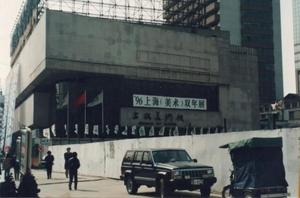 A picture of the inaugural Shanghai Biennale in 1996. (PHOTO PROVIDED TO CHINA DAILY)
A picture of the inaugural Shanghai Biennale in 1996. (PHOTO PROVIDED TO CHINA DAILY)
Gu Jianjun, deputy director of the Shanghai Art Museum at that time, recalls the many complaints he received during the 2004 Shanghai Biennale.
"People passing by the area, especially elderly people living nearby, called in repeatedly to report about the malfunctioning clock," he recalls. "They said they needed to read the time, but the clock was broken and 'running wild'."
Now deputy director of the PSA, which has been hosting the Shanghai Biennale since 2012, Gu says the event has "nurtured the city's first audiences of contemporary art". He notes that, at the first few editions of the Shanghai Biennale, visitors were confused and criticized the artworks as "phony", "vulgar" and "incomprehensible".
Gong Yan, head of the PSA, says that the Shanghai Biennale has in its 24 years of evolution gradually established a distinctive identity that is closely related to the city of Shanghai and contemporary Chinese society.
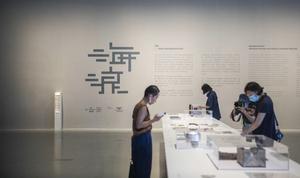 Visitors view works of the ongoing Shanghai Waves: Historical Archives and Works of Shanghai Biennale, which runs through Nov 15. (PHOTO PROVIDED TO CHINA DAILY)
Visitors view works of the ongoing Shanghai Waves: Historical Archives and Works of Shanghai Biennale, which runs through Nov 15. (PHOTO PROVIDED TO CHINA DAILY)
The Shanghai Biennale has since its establishment in 1996 been hosted by the Shanghai Art Museum. In 2012, the museum moved to the former China Pavilion of World Expo 2010 and changed its name to China Art Museum Shanghai, ceding the hosting rights of the biennale to the PSA.
In the past 24 years, the Shanghai Biennale has played an active part in the development of Shanghai's contemporary art scene, says Gong. A large number of galleries and private museums were established in Shanghai, and the corporate world became increasingly interested in sponsoring art, which provided an important foundation for the prosperity of art trading and a healthy art ecosystem, she adds.
As the pandemic has resulted in the cancellation and postponement of several exhibitions by overseas artists, the PSA decided to make a retrospective study of the Shanghai Biennale through this exhibition.
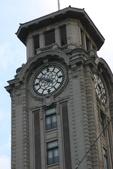 The installation, titled Dang, Dang, Dang, was created by Shanghai-based artist Xu Zhen for the 2004 Shanghai Biennale, a bold readjustment of the vintage clock on the bell tower of the Shanghai Art Museum, to symbolize the fast pace and dynamic nature of urban life. (PHOTO PROVIDED TO CHINA DAILY)
The installation, titled Dang, Dang, Dang, was created by Shanghai-based artist Xu Zhen for the 2004 Shanghai Biennale, a bold readjustment of the vintage clock on the bell tower of the Shanghai Art Museum, to symbolize the fast pace and dynamic nature of urban life. (PHOTO PROVIDED TO CHINA DAILY)
On show are artworks, including paintings, sculptures, videos and installations, from the previous Shanghai Biennale that were collected by the PSA and the Shanghai Art Museum, that are now part of the collection at China Art Museum Shanghai. Many artists have also brought items from their studios, including tools, materials, manuscripts, photographs and books. Visitors will learn about the historical context where these contemporary Chinese artists built their careers, the cultural impact they made and details of special significance in their individual experiences.
"The title Shanghai Waves was borrowed from a novel by British author Virginia Woolf," says Huang, the curator.
"We want to say that, like waves rolling over the beaches, history washes over everybody, leaving all kinds of traces on individual memories. The exhibition is meant to review the history of the Shanghai Biennale and present the connections between individual artists and the world, and society and the vast ocean of history."
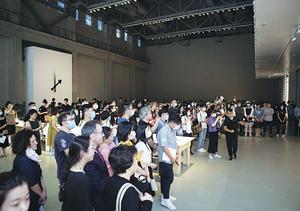 Visitors attend the opening of the Shanghai exhibition. (PHOTO PROVIDED TO CHINA DAILY)
Visitors attend the opening of the Shanghai exhibition. (PHOTO PROVIDED TO CHINA DAILY)
This year, the 12th Shanghai Biennale, titled Bodies of Water, will take place as planned in November.
"Human bodies are 80 percent water, and like many metropolises in the world, waterways have been of great importance to the evolution of Shanghai as a city," says Xiang Liping, a member of the curatorial team of the upcoming 12th Shanghai Biennale.
The epidemic has also inspired artists to work on the connections between humans and nature, as well as the interactions between individuals in the global practice of social distancing, she says.
Bodies of Water will first be presented online from November until next May, when it will be shown at the PSA.
"We are working with programmers to explore all kinds of online expressions," Gong says. "There are many unknown possibilities, and it will be lots of fun."
If you go
Shanghai Waves: Historical Archives and Works of Shanghai Biennale
11 am-7 pm, Tuesday-Sunday, July 31 to Nov 15. Power Station of Art, 678 Miaojiang Road, Huangpu district, Shanghai. 021-3110-8550.
Contact the writer at zhangkun@chinadaily.com.cn


